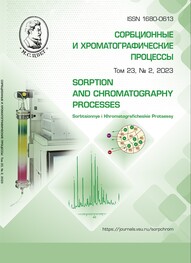Анализ эффективности сорбционного удаления цинка из водных растворов нанокомпозитом на основе оксида графена и углеродных нанотрубок
Аннотация
Современным подходом к решению задач экологической безопасности водных объектов является использование жидкофазных сорбционных методов, основанных на применении новых типов комплексных наноструктурированных адсорбентов. Углеродные наноматериалы и их модифицированные формы, обладающие уникальными физико-химическими и эксплуатационными характеристиками, позволяют обеспечить высочайшую эффективность очистки водных объектов. При этом наноматериалы могут обеспечить извлечение одновременно нескольких типов загрязнителей как органической, так и неорганической природы. Такое преимущество достигается за счет синергетического эффекта – развитой удельной поверхности наносорбентов наряду с возможностью химического модифицирования поверхности и привития широкого спектра активных функциональных групп. В работе проведены кинетические сорбционные исследования процесса извлечения ионов цинка Zn (II) синтезированными нанокомпозитами. Данные материалы представляют собой сорбенты на основе восстановленного оксида графена и окисленных углеродных нанотрубок, модифицированных функциональным органическим компонентом – полианилином и фенолформальдегидной смолой. В работе оценивалось влияние режимных параметров получения нанокомпозитов (карбонизация, метод сушки) на их сорбционную способность. Исследования проводились для аэрогельной формы материалов, а также для карбонизированных аэрогеля и криогеля. Описание кинетики адсорбции проводилось с помощью следующих эмпирических моделей: псевдо-первого порядка, псевдо-второго порядка, модели Еловича. Механизм адсорбции цинка на полученных материалах исследовали с использованием диффузионных моделей – Морриса-Вебера (внутричастичная диффузия) и Бойда (пленочная диффузия). Результаты проведенных экспериментов показали, что за первые 10 мин была достигнута адсорбционная емкость аэрогеля, карбонизированного аэрогеля и карбонизированного криогеля – 200, 110, 178 мг/г, соответственно. Установлено, что поглощение осуществляется по смешанно-диффузионному механизму с вкладом химического взаимодействия между ионом металла и функциональными группами сорбента.
Скачивания
Литература
Mukhin V.M., Burakova I.V., Burakov A.E. Active carbon as nanoporous material for solving environmental problems. Advanced Materials & Technologies. 2017; 2: 50-56. https://doi.org/10.17277/amt.2017.02.pp.050-056
Rajendran S., Priya A.K., Kumar P. S., Hoang T.K.A., Sekar K., Chong K.Y., Khoo K.S., Ng H.S., Show P.L. A critical and recent developments on adsorption technique for removal of heavy metals from wastewater-A review. Chemosphere. 2022; 303(2): 135146. https://doi.org/10.1016/j.chemosphere.2022.135146
Scherz H., Kirchhoff E. Trace elements in foods: Zinc contents of raw foods – A comparison of data originating from different geographical regions of the world. Journal of Food Composition and Analysis. 2006; 19(5): 420-433. https://doi.org/10.1016/j.jfca.2005.10.004
Torres C.E.I, Quezada T.E.S., Kharissova O.V., Kharisov B.I., Gomez M.I. Carbon-based aerogels and xerogels: Synthesis, properties, oil sorption capacities, and DFT simulations. J. Environ. Chem. Eng. 2021; 9(1): 104886. https://doi.org/10.1016/j.jece.2020.104886
Meena A.K., Mishra G.K., Rai P.K., Pajagopal C., Nagar P.N. Removal of heavy metal ions from aqueous solutions using carbon aerogel as an adsorbent. J. Hazard. Mater. 2005; 122(1-2): 161-170. https://doi.org/10.1016/j.jhazmat.2005.03.024.
Tsink v stochnykh vodakh. Available at: https://nortest.pro/stati/voda/cink-v-stochnyh-vodah.html (accessed 1 December 2022).
Sanitarnye pravila i normy SanPiN1.2.3685-21 «Gigienicheskie normativy i trebovaniya k obespecheniyu bezopasnosti i (ili) bezvrednosti dlya cheloveka faktorov sredy obitaniya». Available at: https://docs.cntd.ru/document/573500115#6540IN (accessed 1 December 2022).
Godwin P.M., Pan Y., Xiao H., Afzal M.T. Progress in preparation and application of modified biochar for improving heavy metal ion removal from wastewater. Journal of Bioresources and Bioproducts. 2019; 4(1): 31-42. https://doi.org/10.21967/jbb.v4i1.180
Qian H., Wang J., Yan L. Synthesis of lignin-poly(N-methylaniline)-reduced graphene oxide hydrogel for organic dye and lead ions removal. Journal of Bioresources and Bioproducts. 2020; 5(3): 204-210. https://doi.org/10.1016/j.jobab.2020.07.006
Burakov A.E., Galunin E.V., Burakova I.V., Kucherova A.E., Agarwal S., Tkachev A.G., Gupta V.K. Adsorption of heavy metals on conventional and nanostructured materials for wastewater treatment purposes: A review. Ecotoxicol. Environ. Saf. 2018; 148: 702-712. https://doi.org/10.1016/j.ecoenv.2017.11.034
Adel M., Ahmed M.A., Elabiad M.A., Mohamed A.A. Removal of heavy metals and dyes from wastewater using graphene oxide-based nanomaterials: A critical review. Environmental Nanotechnology, Monitoring and Management. 2022; 18: 100719. https://doi.org/10.1016/j.enmm.2022.100719
Huo P., Xing G., Tian L., Zhang G., Wang H., Yu C., Li Y., Wu Z. Hollow carbon spheres/graphene hybrid aerogels as high-performance adsorbents for organic pollution. Sep. Purif. Technol. 2019; 213: 524-532. https://doi.org/10.1016/j.seppur.2018.12.032
Deshwal N., Singh M.B., Bahadur I., Kaushik N., Kaushik N.K., Singh P., Kurami K. A review on recent advancements on removal of harmful metal/metal ions using graphene oxide: Experimental and theoretical approaches. Sci. Total Environ. 2023; 858: 159672. https://doi.org/10.1016/j.scitotenv.2022.159672
Pinelli F., Piras C., Rossi F. A perspective on graphene based aerogels and their environmental applications. FlatChem. 2022; 36: 100449. https://doi.org/10.1016/j.flatc.2022.100449
Kuznetsova T.S., Burakova I.V., Pasko T.V., Burakov A.E., Melezhik A.V., Mkrtchyan E.S., Babkin A.V., Neskoromnaya E.A., Tkachev A.G. Technology of nanocomposites preparation for sorption purification of aqueous media. Inorg. Mater.: Appl. Res. 2022; 16(2): 434-441. https://doi.org/10.1134/S2075113322020447
Lu C., Chiu H. Adsorption of zinc(II) from water with purified carbon nanotubes. Chem. Eng. Sci. 2006; 61(4): 1138-1145. https://doi.org/10.1016/j.ces.2005.08.007
Gan G., Li X., Fan S., Wang L., Qin M., Yin Z., Chen G. Carbon Aerogels for Environmental Clean-Up. Eur. J. Inorg. Chem. 2019; 2019(27): 3126-3141. https://doi.org/10.1002/ejic.201801512
Maleki H. Recent advances in aerogels for environmental remediation applications: A review. Chem. Eng. J. 2016; 300: 98-118. https://doi.org/10.1016/j.cej.2016.04.098
Lee J-H., Park S-J. Recent advances in preparations and applications of carbon aerogels: A review. Carbon. 2020; 163: 1-18. https://doi.org/10.1016/j.carbon.2020.02.073
Hummers W.S., Offeman R.E. Preparation of graphitic oxide. Journal of American Chemical Society. 1958; 80(6): 1339. https://doi.org/10.1021/ja01539a017
Tkachev A.G., Melezhik A.V., Osipov A.A., Tkachev M.A. Patent RF, no. 2709594, 2019.
Lagergren S. About the theory of so-called adsorption of soluble substances. Sven. Vetenskapsakad. Handingarl. 1898; 24: 1-39.
Ho Y., McKay G. The sorption of lead (II) ions on peat. Water Research. 1999; 33(2): 578-584.
McLintock I. The Elovich equation in chemisorption kinetics. Nature. 1967; 216(5121): 1204.
Weber W., Morris J. Intraparticle diffusion during the sorption of surfactants onto activated carbon. Journal of the Sanitary Engineering Division. 1963; 89(1): 53-61.
Boyd G.E., Adamson A.W., Myers Jr L.S. The exchange adsorption of ions from aqueous solutions by organic zeolites, II: Kinetics. Journal of the American Chemical Society. 1947; 69: 2836-2848








